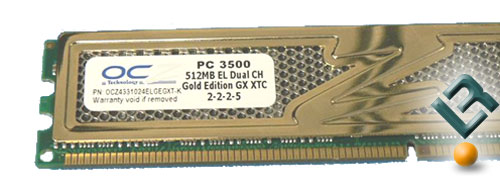Do Memory Heat Spreaders Make A Difference?
Corsair Examines The Competition
Corsair Memory has recently done some internal benchmarking of Corsair and OCZ heat spreaders. Corsair passed along this information to the editors of all the review sites you read and I thought that it would only be fair to pass this information to the community for consumption. Here is the original document that Corsair made when they tested the heat spreaders with some paragraphs from the newly published .pdf that was sent to press and might make it to their Tech Notes site.
From Corsair Memory:
In the interest of full disclosure, I think it?s only fair starting this out by acknowledging that I work for Corsair, so those of you who want to poke holes in this lab report, there?s your first piece of ammunition. There?s been lots of discussion recently about what type of heat spreader is best for overclocking. Or, if no heat spreader is best of all. We decided to run some tests ourselves, and see what kind of results we got.
Background
First, let?s look at some basic theory on heat removal from integrated circuits. According to Micron Semiconductor application note TN-00-08, heat is most efficiently removed from memories via conduction (through a medium like metal, or water), rather than convection (through the air). And, heat is removed most efficiently (over 75%, according to Micron?s tests) through the metal pins into the ground plane of the PCB. The secondary means of heat removal is through the back of the die into the package, and from the package into air via convection. Once you are trying to dissipate heat into air, what matters is the surface area exposed to air. A heat spreader does just what is says, it spreads the heat over a larger s urface area for more efficient dissipation. And, a heat sink takes this one step further, by adding fins and increasing the surface area that much more. That is why we see large heat sinks with fins (and sometimes fans) on high power semiconductors such as CPUs and power transistors.
All our tests used the RST Pro card?s ?Stress Test? to heavily exercise the memory. The tests were run in one of our qual ovens at exactly 68 degrees F ambient temperature. Our standard stability test includes 3 iterations of the RST Pro2 ?Burn in? option, with Stuck, Weave, Jump, Primes, Parity, Pseudo Random, ATS, and Crosstalk turned on. This may seem confusing, and may be more information than needed, but this is how we test our internal memory before it goes through the 24-hour qualification torture test, so I figured it was only fair to disclose this as well. A ?pass? was considered to be three consecutive iterations of the stress test with zero errors. Each test was run not once, but twice, to confirm results. In all cases the second test yielded exactly the same results as the first.
A while back OCZ announced their ?Xtreme Thermal Convection? heatspreader.
Here?s a quote about how the XTC heatspreader works, according to OCZ:
?The unique design used in the XTC heatspreaders optimizes the thermal management of memory modules by promoting greater airflow by means of micro-convection throughout what is usually the dead air space inside conventional heatspreader designs. In this manner, build-up of heat is avoided and thermal dissipation of the memory components is offloaded more efficiently through the honeycomb design.?
This is an interesting proposition, one that we at Corsair were dying to test out. We?re always looking for new ideas, and internally we?d been pretty convinced that air was a poor means of thermal transfer. This was our assumption based on those pesky laws of thermodynamics. Using previously obtained knowledge that metal conducts heat better than air, we?d designed our heatspreaders to make as much contact with the IC as possible, but maybe this ?air pocket? theory has something to it?
We purchased some modules for this purpose. These modules are built with RAMs that tolerate very high voltage – and with high voltage comes high power dissipation (and temperature), as power goes up when voltage is increased (P = V^2 / R, for those of you who like equations…) Our goal was to put this memory through a nightmare scenario where heat was limiting our overclock. As such, we purchased these modules on the web. No, they are not supplied by Corsair!

These modules are rated at 217 Mhz at 2-2-2-5, and appear to be based on Winbond ICs.

Comments are closed.